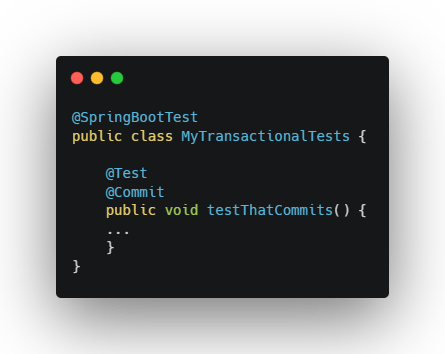Mastering Transaction Management in Spring Tests: Rollback, Commit, and Best Practices
- michalkrysiuk64
- Feb 19
- 2 min read
Updated: Feb 20

In Spring's testing framework, transactional tests are designed to ensure that every test method runs in isolation by default. Each test method is wrapped in a transaction that is automatically rolled back upon completion. This behavior guarantees that the state of the database remains pristine between tests, which is crucial for maintaining consistency and avoiding unintended side effects.
The Default Rollback Behavior
By default, the Spring TestContext framework creates a transaction for each test method and rolls it back when the method completes. This mechanism offers several benefits:
Clean Database State: Each test begins with a fresh database, eliminating dependencies on residual data.
Test Isolation: Tests do not interfere with one another, ensuring that failures in one test do not cascade into others.
Simplified Cleanup: With automatic rollback, there is no need to manually clean up test data.
According to the official Spring documentation on Transaction Management, this strategy is ideal for most test scenarios, allowing developers to assume the presence of a transaction without worrying about its impact on the persistence store.
Disabling Rollback: Committing Test Transactions
There are instances where you may want the transaction to commit after the test method completes—perhaps to verify the changes in the database or to populate the database for subsequent tests. Spring provides two annotations to disable the default rollback behavior:
@Commit This annotation explicitly instructs the framework to commit the transaction after the test method finishes.
Example:
@SpringBootTest
public class MyTransactionalTests {
@Test
@Commit
public void testThatCommits() {
...
}
}@Rollback(false)By setting the rollback flag to false, this annotation similarly directs the framework to commit the transaction instead of rolling it back.
Example:
@SpringBootTest
public class MyTransactionalTests {
@Test
@Rollback(false)
public void testThatCommits() {
...
}
}Both @Commit and @Rollback(false) achieve the same effect: they disable the automatic rollback, allowing the test's database modifications to persist.
Best Practices for Transactional Tests
Default to Rollback: In most cases, it is best to let the framework roll back transactions automatically. This ensures that your tests remain isolated and the database remains clean.
Selective Commit: Use @Commit or @Rollback(false) only when you have a specific need to inspect the database state after test execution.
Clean Up After Committing: If you commit changes for a test, consider additional cleanup strategies to avoid polluting the database for subsequent tests.
Transactional Assertions: Leverage transactional tests to assert behaviors that require a transaction context (e.g., verifying cascading operations, lazy loading, etc.).
Be Cautious with External Effects: Tests that interact with real databases should minimize side effects. Avoid committing transactions unless absolutely necessary to prevent interference with other tests or environments.
Conclusion
Understanding how Spring manages transactions in tests is key to creating reliable, maintainable, and isolated test suites. While the default rollback behavior keeps your database clean and tests independent, there are cases where you might need to commit transactions. In such cases, use the @Commit or @Rollback(false) annotations to override the default behavior.
For a deeper dive into these concepts, refer to the official Spring Transaction Management documentation. By adhering to these best practices, you can ensure that your tests remain robust and your database stays in a predictable state.
Happy coding!



Comments